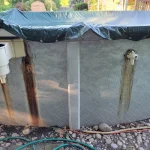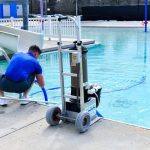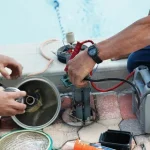Fun and relaxation abound as well as a terrific way to cool yourself in the heat from ground pools. Like any other home element, they do, however, demand continuous upkeep and attention. Knowing the inground pool cost of rebuilding an inground pool will enable you to budget and prevent unanticipated financial burden from patching cracks to replacing pool equipment. This page will explore in great detail the expenses related to inground pool repair, elements influencing these expenses, and some preventative maintenance ideas to maintain your pool in good shape.
Typical Inground Pool Cost For Maintenance
Repairing an inground pool will cost different depending on the issue you are running across. The most often occurring repairs are broken out here along with the related expenses:
1. Structural repairs
Particularly with concrete or fiberglass pools, structural degradation is one of the most important problems pool owners deal with. Shifting ground, water pressure, or basic wear and strain over time can all cause cracks. Depending on the degree of damage, this kind of repairs usually cost the most.
Little cracks could be easy to fix and range in cost from $500 to $1,000. If the damage is more severe, repairs depending on the degree of the fracture and the kind of material your pool is constructed from might cost anywhere from $1,000 to $10,000 or more.
Complete Pool Resurfacing: Should cracks be prevalent, you might have to resurface the entire pool, costing possibly $10,000.
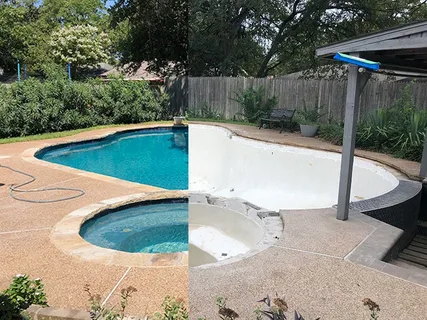
2. Pool Equipment Replacements and Repairing Notes
Maintaining the integrity, temperature, and safety of your pool depends on pool equipment including heaters, filters, and pumps. These gadgets could malfunction or wear out with time and require either repair or replacement.
Should your pool pump be broken, it can be fixed for $200 to $800. Should the pump be old or beyond repair, you could have to replace it at expenses ranging from $500 to $1,200.
Should your pool filter require maintenance, you can find yourself looking at repairs costing $150 to $300. Should the filter be beyond repair, replacement expenses could run from $800 to $1,500.
Replacement for Heater Repairs Additionally prone to problems over time are pool heaters. Should a heater require repairs, the expense falls between $300 and $900. Depending on the kind of heater you have—gas, electric, or solar—replacing a damaged heater beyond repair might run between $1,500 and $3,500.
3. Replacements and Liner Repairs
Although many inground pools contain vinyl liners, over time they might cause leaks, splits, or wrinkles. These problems could cause less appealing pool surface or water loss. Minor tear or damage calls for repairs ranging in cost from $200 to $500.Should your liner have to be replaced totally, you should budget between $1,000 and $5,000. The pool size, liner quality, and degree of installation intricacy will all affect the cost.
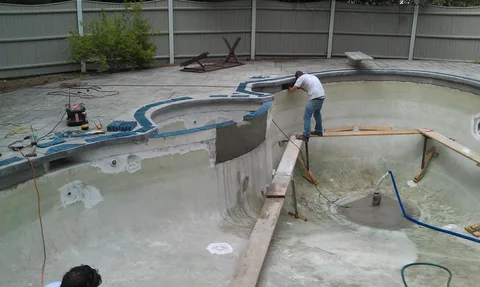
4. Resurfacing and Surface Repairs
Particularly with regard to chemicals, sunshine, and water pressure, pool surfaces eventually wear out. Resurfacing is required to maintain your pool operational, but depending on the kind of surface it can be somewhat expensive.
Pools with plaster finishes could need resurfacing every 10 to 15 years. Usually costing between $5,000 and $10,000, this kind of service is
Usually costing $20 to $50 per tile, tile repairs are needed when tiles break or come free. Should the whole pool require retiles, the cost might be $15,000 or more.
With resurfacing rates starting at $8,000 and rising depending on the size and material utilized, pools with pebble finishes or aggregate surfaces typically find their repairs more costly.
Repair and Cost Summary
Inground Pool Repair Costs
Here’s a quick reference table to summarize essential pool repairs and their costs:
| Repair/Item | Description | Estimated Cost |
|---|---|---|
| Structural Repairs | Fixing cracks in the pool surface or walls. | $500–$10,000+ |
| Pump Repairs/Replacement | Fixes or replacement for faulty pool pumps. | $200–$800 (repair), $500–$1,200 (replacement) |
| Filter Repairs/Replacement | Cleaning or replacing pool filters. | $150–$300 (repair), $800–$1,500 (replacement) |
| Heater Repairs/Replacement | Repairs or replacement for pool heaters. | $300–$900 (repair), $1,500–$3,500 (replacement) |
| Liner Repairs | Fixing small tears or wrinkles in vinyl liners. | $200–$500 |
| Liner Replacement | Replacing an old or damaged liner. | $1,000–$5,000 |
| Plaster Resurfacing | Resurfacing the pool with plaster. | $5,000–$10,000 |
| Tile Repairs | Fixing or replacing damaged pool tiles. | $20–$50 per tile |
| Tile Retiling | Retiling the entire pool surface. | $15,000+ |
| Pebble or Aggregate Resurfacing | Repairing or resurfacing with pebble finishes. | $8,000+ |
The following is a fast reference table including the expenses of key pool repairs:
Table Factors influencing Pool Repair Costs
Although the kind of repair is most crucial, numerous additional factors might affect the cost of pool repairs:

- Larger pools demand more supplies and take more time to fix, which raises the expenses.
- The type of material your pool is built from—concrete, fiberglass, vinyl, etc.—may influence the repair cost. Concrete pool repair cost, for instance, usually costs more than vinyl pools.
- Depth of Damage: The repair will cost more the more severe the damage is. While simple cracks would only cost a few hundred dollars to repair, serious structural problems or resurfacing might run thousands of dollars.
- Location: Because labor rates and material prices vary, pool repair expenses will also vary. Pools in high cost of living areas sometimes have more repair costs. Urgent repair need: Emergency repairs done off-season or those needing quick attention could cost more depending on rush fees or personnel availability. Preventive Care to Cut Repair Costs
- Early intervention and regular maintenance help to lower the demand for expensive repairs. These pointers will help you to maintain the good shape of your pool:
- Vacuum your pool, routinely clear trash, and scrub surfaces. This stops discoloration, algae growth, and accumulation—all of which could cause costly repairs.
- Check water chemistry: Maintaining balanced pH levels, chlorine, and alkalinity will help to guard the surface of the pool and equipment from harm. Corrosion, discoloration, and material deterioration on the pool can all result from bad water chemistry.
- Examine Equipment: Examining the pump, filter, and heater of the pool should become second nature to you in search of wear or damage. Early small issue identification helps to avoid more major difficulties down the road.
- Quickly fix minor problems. Take rapid care of minor cracks, leaks, or equipment issues you find. Early small fixes help to avoid minor problems becoming more costly ones.
Reasonably Luxurious with Semi-Inground Pool Cost
A semi inground pool strikes the ideal mix between elegance and cost. A semi-inground pool’s cost usually falls between $8,000 and $20,000 depending on size, material, and extras like heating systems or decking. Homeowners looking for a fashionable but reasonably priced swimming solution often choose this option since it offers the visual attractiveness of an inground pool at a fraction of the expense. A semi-inground pool offers a pleasant experience without splurging by improving your backyard while maintaining within your financial range with flexible designs and customizing choices.
Using Inground Pool Kits, Customize Your Pool.
Customizing a swimming pool is made easy and reasonably priced with in-ground pool kits. These kits have basic building elements such walls, liners, piping, and steps, therefore simplifying the design process for a pool fit for your backyard. Available in a range of forms and sizes, they let homeowners customize the pool to fit their tastes and help to save expert installation fees. Perfect for do-it-yourself projects or limited expert help, inground pool kits provide a reasonably priced way to build a premium, personalized pool. Pool aficionados often choose this option since it offers both cost and flexibility.
1. How expensive is it typically to fix an inground pool?
Depending on the repair required, the cost can run anywhere from $200 to $5,000 or more. While large repairs like resurfacing or structural damage repairs are far more costly than minor solutions like lining repairs,
2. Fixing a damaged inground pool cost how much?
Repairing pool surface cracks can be expensive; rates range from $500 to $10,000. The degree of the cracking and the pool’s composition will determine the cost. Does insurance pay for pool repairs? Homeowners insurance would cover particular events like storms or mishaps causing pool repairs. Insurance usually does not cover, though, regular wear and tear, neglect, or problems resulting from inadequate installation.
4. How often should I bring my ground pool back to life?
Average cost of inground pool to back in life Usually every ten to fifteen years, plaster pools need resurfacing. More durable coatings like tile or pebble on pools might help them to last longer. The material will determine whether resurfacing expenses fall within $5,000 and $10,000.
5. Which is better—repairing or replacing pool equipment?
Inground pool prices installed equipment Usually, replacing a damaged piece of equipment is the wiser choice if the repair expenses more than half the price of a new one. More energy-efficient newer equipment might also save you money over time.
Last Words
Although maintaining an inground pool calls for care and repairs, knowing the expenses associated will enable you to properly budget. Good planning, timely repairs, and regular maintenance will help to keep your pool in excellent shape without running afoul of your means. Prevention is the secret to saving money on repairs; monitor the state of your pool, spot problems early on, and fix them before they get more serious. This will help you to keep enjoying your pool for years to come free from worry about unanticipated repair costs.


